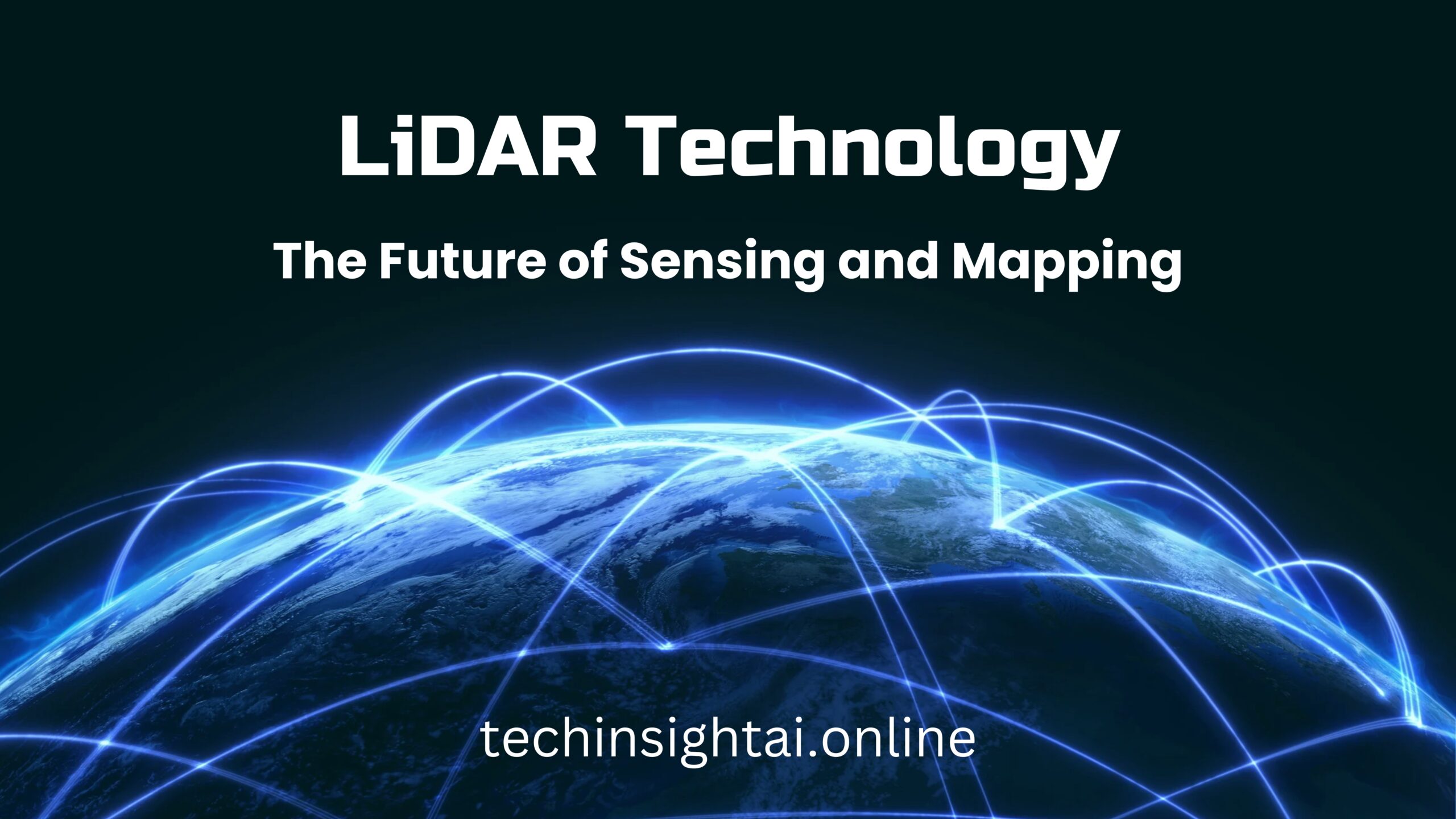LiDAR Technology: The Future of Sensing and Mapping
LiDAR era has revolutionized the manner we perceive and have interaction with the environment. From self sufficient motors to environmental monitoring, this contemporary generation is shaping industries and redefining how we navigate, map, and apprehend the physical global. In this newsletter, we’re able to delve into the basics of LiDAR generation, its cutting-edge day tendencies, and its diverse applications.

What is LiDAR Technology?
LiDAR stands for Light Detection and Ranging. It is a far flung sensing approach that makes use of laser mild to diploma distances to the Earth’s surface. The primary precept in the back of LiDAR generation is to emit laser pulses and diploma the time it takes for the ones pulses to go back after reflecting off a ground. This time c programming language is then used to calculate distances, which permits the introduction of sure, high-resolution maps of the location scanned.
LiDAR structures normally include three most important components:
- Laser: The laser emits pulses of light toward a target.
- Scanner: A scanner collects the meditated light and statistics the time it took for the light to return.
- GPS receiver: This information the precise place and altitude in which the records is gathered, ensuring spatial accuracy.
The Evolution of LiDAR Technology
LiDAR technology has evolved notably due to the fact its inception inside the Sixties. Early programs targeted on atmospheric studies, however fast improvements in laser era, GPS, and computing energy have accelerated its use throughout numerous industries. In recent years, the miniaturization of sensors, improvements in accuracy, and fee reductions have propelled LiDAR into mainstream packages. One of the most outstanding regions wherein LiDAR technology has received traction is within the automobile enterprise, in particular for self-riding cars. Today’s LiDAR structures are extra compact, strength-green, and able to seize hundreds of thousands of facts points in step with 2nd, making them precious for packages requiring precision and actual-time facts processing.
How LiDAR Technology Works
To apprehend the inner workings of LiDAR era, it’s crucial to discover its two primary sorts: Airborne LiDAR and Terrestrial LiDAR.
Airborne LiDAR Technology
Airborne LiDAR is generally used for big-scale mapping and topographic surveys. The sensor is hooked up on an plane or drone and captures records over huge geographical areas. This method is specially effective in creating Digital Elevation Models (DEMs), which constitute the Earth’s floor in three dimensions. Airborne LiDAR structures emit hundreds of laser pulses according to 2d, which scan the surface under as the plane flies over. Each pulse provides an accurate measurement of elevation, allowing the introduction of surprisingly unique terrain models. This technology is often utilized in city planning, flood modeling, and forestry management.
Terrestrial LiDAR Technology
Terrestrial LiDAR, however, is used for ground-based programs. Mounted on a tripod or automobile, the device scans items and landscapes from a stationary or mobile role. Terrestrial LiDAR is vital in industries like architecture, construction, and archaeology, wherein fairly accurate and exact measurements of buildings, systems, or excavation websites are required.
Key Applications of LiDAR Technology
LiDAR era has observed applications throughout a huge spectrum of industries, contributing to performance, protection, and innovation. Below are some of the most huge programs:
LiDAR Technology in Autonomous Vehicles
Autonomous cars depend closely on LiDAR generation for navigation and impediment detection. LiDAR sensors create a three-D map of the vehicle’s surroundings, allowing it to come across and keep away from limitations, pedestrians, and different cars. Unlike cameras, which might be prone to lights conditions, LiDAR can feature in low-mild environments, making it a dependable preference for self-riding vehicles. Recent improvements in stable-state LiDAR technology have reduced the size and price of these sensors, making them extra accessible for great use inside the car industry. Companies like Waymo and Tesla have incorporated LiDAR sensors into their self-riding structures to enhance safety and situational attention.
LiDAR Technology in Environmental Monitoring
LiDAR era plays a crucial role in environmental monitoring, specifically for reading wooded area biomass, carbon sequestration, and deforestation. By reading the peak and density of plant life, LiDAR facilitates scientists apprehend the impact of weather trade on ecosystems. The technology is likewise used to tune natural world habitats and map coastal erosion, presenting treasured records for conservation efforts. For instance, NASA’s GEDI (Global Ecosystem Dynamics Investigation) is a LiDAR-based project focused on mapping the shape of forests globally. The information collected is assisting scientists degree wooded area carbon and monitor modifications in land use, contributing to global climate fashions.
LiDAR Technology in Archaeology
In archaeology, LiDAR technology has confirmed worthwhile for uncovering ancient civilizations and misplaced towns that are hidden below dense forests or jungles. Traditional excavation methods are regularly gradual and detrimental, however LiDAR can scan sizeable areas of terrain and reveal the outlines of structures with minimal impact on the website online. One of the most well-known discoveries made the usage of LiDAR era is the ancient Mayan metropolis of Tikal, which turned into observed beneath the dense jungle in Guatemala. Archaeologists used airborne LiDAR to map the landscape and find previously unknown structures, demonstrating the potential of LiDAR to revolutionize archaeological studies.
LiDAR Technology in Urban Planning and Construction
In urban making plans, LiDAR is used to create 3-D models of cities, that could help planners and engineers layout infrastructure greater efficaciously. These fashions allow for the evaluation of constructing heights, road layouts, and other capabilities to optimize land use and transportation structures. In production, LiDAR generation is used for site surveying, tracking construction development, and making sure that systems are constructed to specification. Real-time information from LiDAR sensors can help perceive capacity problems early, reducing the chance of costly delays or errors.
LiDAR Technology in Agriculture
Precision agriculture is every other field in which LiDAR generation is making an impact. By the use of LiDAR to map the topography of farmland, farmers can optimize irrigation, planting, and harvesting strategies. The era also can detect variations in crop height and fitness, permitting more green use of sources such as water and fertilizers.
LiDAR Technology in Disaster Management
LiDAR is instrumental in disaster control, especially inside the aftermath of natural screw ups which include earthquakes, landslides, or floods. It can fast create special terrain maps that assist examine the extent of harm and inform recovery efforts. LiDAR’s capacity to map terrain changes through the years additionally makes it treasured for monitoring areas liable to natural dangers, which includes coastal regions prone to flooding or erosion.
Recent Advancements in LiDAR Technology
LiDAR generation is constantly evolving, and recent innovations have multiplied its skills even further. Some of the modern day tendencies consist of:
Solid-State LiDAR
One of the most significant improvements in LiDAR technology is the improvement of solid-country LiDAR structures. Traditional LiDAR sensors depend on mechanical components to rotate and scan the environment. However, strong-state LiDAR gets rid of these transferring elements, resulting in a smaller, more reliable, and cost-powerful sensor. Solid-kingdom LiDAR is in particular appealing for independent cars, wherein size and durability are critical elements. Companies like Velodyne, Luminar, and Ouster have been at the vanguard of developing those compact sensors, which promise to lessen the overall fee of autonomous car systems.
Long-Range LiDAR Technology
LiDAR systems have traditionally been constrained in phrases of range, but new long-variety LiDAR generation is extending the distances at which gadgets can be detected. Companies at the moment are growing sensors which could detect objects over 300 meters away, making them ideal for applications like self-driving automobiles and aerial mapping. Long-range LiDAR sensors offer greater accuracy and situational attention in hard environments, along with highways or mountainous terrain, wherein early detection of barriers is critical for protection.
AI-Enhanced LiDAR Systems
The integration of synthetic intelligence (AI) with LiDAR technology is every other interesting development. AI algorithms can system and examine the huge quantities of records generated with the aid of LiDAR sensors in actual time. This permits systems to become aware of patterns, classify items, and make decisions more efficaciously. In self reliant automobiles, AI-improved LiDAR structures can differentiate among numerous forms of objects, such as pedestrians, cyclists, and motors, enhancing the automobile’s potential to navigate complex environments. Additionally, AI can optimize LiDAR statistics for precise duties, consisting of figuring out plant life in environmental monitoring programs or detecting underground systems in archaeological surveys.

Challenges Facing LiDAR Technology
Despite its many advantages, LiDAR era faces certain demanding situations that should be addressed for broader adoption. These encompass:
- Cost: Although fees have reduced drastically, LiDAR structures can nonetheless be high-priced, mainly for high-resolution sensors used in self sustaining vehicles.
- Weather Conditions: LiDAR overall performance can be stricken by weather situations like heavy rain, fog, or snow, which scatter the laser pulses and decrease accuracy.
- Data Processing: LiDAR structures generate massive quantities of statistics, which calls for enormous computing strength and storage for processing and analysis.
Future Prospects of LiDAR Technology
As LiDAR generation maintains to conform, its programs are expected to enlarge similarly. The integration of LiDAR with different sensing technology, such as radar and cameras, will create greater sturdy and flexible systems for various industries. The upward push of AI-powered LiDAR will also improve performance in data processing and interpretation.
In the destiny, LiDAR may also turn out to be a ubiquitous a part of day by day life, gambling a critical function within the improvement of clever towns, advanced transportation networks, and environmental sustainability efforts.
Conclusion
LiDAR technology is a sport-changing innovation with big potential across industries inclusive of automobile, environmental monitoring, archaeology, and concrete planning. As strong-nation LiDAR, AI-improved structures, and long-range sensors continue to improve, the generation will become extra accessible and flexible, imparting remarkable levels of precision and reliability. Whether it is mapping remote terrains, allowing self sufficient motors, or uncovering lost civilizations, LiDAR era is paving the



